i was comparing two branches of one of our projects for performance, one is much slower than the other. I noticed the GC Run count is higher for one (See graph below).

More interestingly, the running time is many times higher, much more than can e explained by the extra runs. What would explain the 40%(ish) increase in number of runs increasing the running time by a factor of 6? Larger objects? Too many objects? Also what are some of knobs to tune here and what is there effect? (Some good links are fine as an answer)
